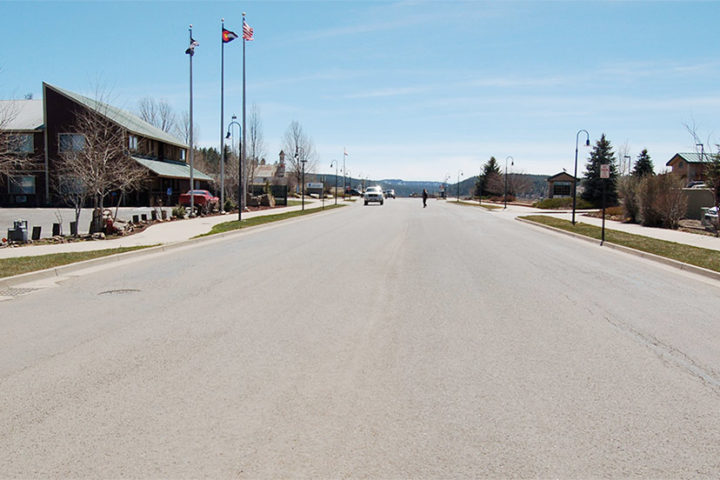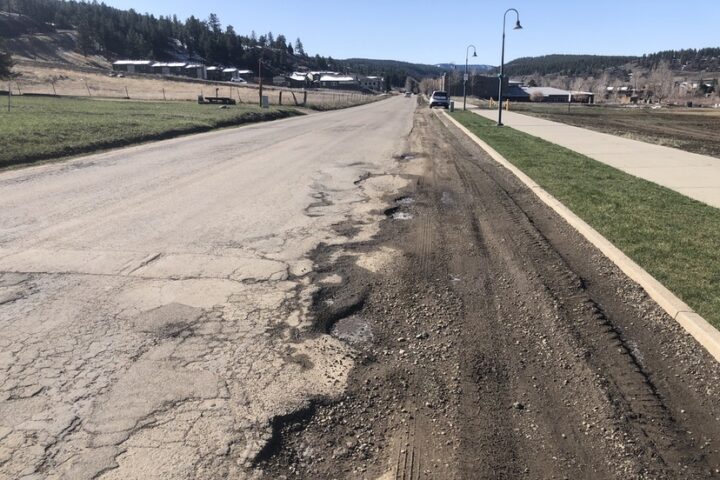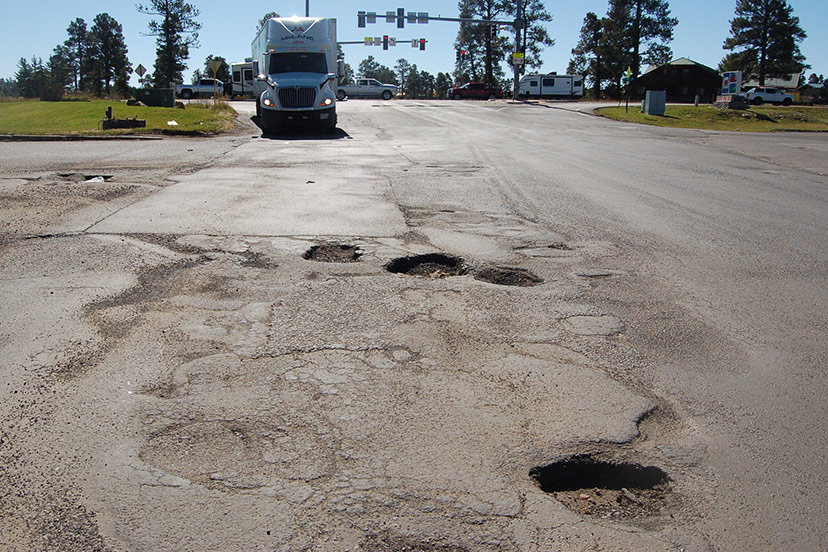Photo: North Pagosa Boulevard, looking south toward the Highway 160 intersection. October 2022.
I enjoyed a recent column by our Daily Post humorist, Louis Cannon, discussing the history of news coverage, and the sometimes strange relationship between ‘history’ and ‘news’.
If I were writing an article about less-than-optimally-maintained road infrastructure in Archuleta County, I could easily be talking about ‘history’. Or just as easily, ‘news’.
The historical potholes at the Highway 160 entrance to North Pagosa Boulevard, for example. We all wish they were ‘history’. Maybe someday?
Or I could be writing about a company known as Dustrol Inc… a name I first heard mentioned at the Archuleta Board of County Commissioners’ work session on April 2.
As a person interested in both history and news, I’ve been writing since 2005 about the challenges faced by the Archuleta County Road & Bridge Department, in their attempts to maintain 40 miles of paved roads and 280 miles of gravel roads with a budget that doesn’t come close to meeting the need, and with a somewhat transitory staff in recent years.
Actually, my first Daily Post article about pavement, in 2005, concerned the best-maintained pavement in the entire county: the runway at Stevens Field airport. That story was a blend of history and news.
As this one is, as well.
About 30 years ago, the Town of Pagosa Springs began paving its downtown streets — previously gravel street. (That is to say, dirt.)

The work was funded largely through the U.S. Department of Transportation’s ‘Congestion Mitigation and Air Quality Improvement’ (CMAQ) program, which provides funding to states for transportation projects designed to reduce traffic congestion and improve air quality — particularly in areas of the country that do not attain national air quality standards.
We didn’t have traffic congestion in downtown Pagosa, 30 years ago, but we did have poor air quality, thanks to the fine clay dust generated by vehicles driving on dirt roads. A steady flow of annual grants from U.S. DOT helped the Town pave its streets and purchase a street sweeper.
As I understand asphalt pavement, it typically lasts about 25 years, if properly maintained. Some downtown streets have been properly maintained. Some have not. Some are still not completed.

The above photo of Hot Springs Boulevard — one of our main downtown streets — was taken a few days ago. The street paving is still unfinished, 20 years after the new sidewalks and curb were installed.
Meanwhile, the situation is similar out in the unincorporated county, where 85% of the community’s population resides. Except that the vast majority of County roads are not paved, but gravel. (Or dirt.)
County Road & Bridge has not been able to fully maintain either type of road — paved or gravel.
Recycling, to the rescue?
At their April 2 regular meeting, the Archuleta Board of County Commissioners approved two proposed road projects… and awarded the contract for reconstruction of North Pagosa Boulevard from Bastille Drive to U.S. 160, plus a portion of Navajo Trail Drive adjoining North Pagosa Boulevard.
At the BOCC work session earlier that day, the commissioners heard an update on road projects from Public Works Director Mike Torres. Mr. Torres explained that he’s been in conversations with a Kansas-based company named Dustrol Inc.
From the ForConstructionPros.com website:
Dustrol, based in Towanda, KS, near Wichita, was founded in 1973 by Ted Dankert when he began selling emulsions for sealing asphalt and controlling dust…
In 1979, Dustrol purchased its first cold milling machine and began focusing exclusively on asphalt recycling and resurfacing. Today it provides asphalt recycling and related highway maintenance services. Its geographic focus includes Kansas, Colorado, Texas, Oklahoma, Nebraska, New Mexico and Missouri. Recently the company has been building its presence in additional markets including Iowa, Arizona, Arkansas, Louisiana, Wyoming and Utah.
These days, the company is focusing on customized Hot In-place Recycling (HIR) preservation trains to grow both its markets and its profits. Brian Hansen, vice president, with Dustrol, says there are several different types of HIR methods, but Dustrol uses its specialized MARS (Mobile Asphalt Recycling System) process that it customizes for each job. The company has done several projects in the above-mentioned states using the MARS method.
As I understand asphalt paving for streets and roads, the material is basically a mixture of crude oil and gravel that’s heated and applied at temperatures between 300 and 350 degrees Fahrenheit. This is called Hot Mix Asphalt (HMA). and it’s apparently the most commonly used type of asphalt.
HMA can be classified into three categories, including dense-graded mixes, stone matrix asphalt and open grade mixes. Fine-graded dense-grade mixes contain a higher percentage of sand and small stones compared to its coarse-graded counterpart. This type of mix can be used to pave high-traffic roads, interstates and highways.
So I supposed we should all hope that the County has been specifying “dense-graded mixes” on its most important paving projects over the past 30 years… because it sounds like Mr. Torres would like to hire Dustrol Inc. to recycle some of our asphalt.
At a huge cost savings, compared to laying fresh asphalt.
Mr. Torres explained to the commissioners that the recycling process used by Dustrol — ‘Hot In Place Recycling’ (HIR) — involves milling up “the first couple of inches” of the existing asphalt, heating the millings on the spot, and then immediately laying the hot mixture back down, on the same road.
This is in contrast to companies that mill up old asphalt and truck it away to a facility, for future ‘recycling’.
Mr. Torres has asked Dustrol to provide additional information about “what they can do for Archuleta County…”

